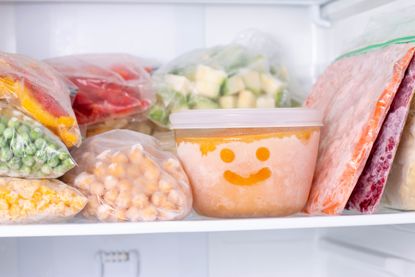Organizing a chest freezer – 10 ways to keep your cool when storing frozen food
Organizing a chest freezer may feel daunting, but it’s well worth the effort – do it properly to ensure fresh-tasting frozen food that’s always easy to find

Organizing a chest freezer is no mean feat. But if yours is full of forgotten leftovers and impromptu supermarket buys, now is probably the time to tackle the task head on.
Due to their size, they’re usually positioned elsewhere in the home, such as the garage or utility room, so when it comes to organizing a kitchen, it’s not surprising they often get forgotten about. However, including organizing a chest freezer in your list of to-dos is essential. A well-ordered cooking zone is not much good without an equally well-ordered food storage system in place… the two go hand in hand.
Organizing a chest freezer is time well spent for several reasons: firstly, it maximizes space for food storage; secondly, it makes food easier to access. No more rummaging around for what you need saves you and effort, and potentially frostbite, too. Lastly, you’ll have a clearer idea of what food items are in there and when they need to be eaten. This means you’re less likely to buy food you don’t need, which in turn, should result in less clutter, less money spent and less food waste overall.
It feels like a no-brainer, doesn’t it? With that in mind, we’ve gathered some of the easiest ways to go about organizing a chest freezer, to help you keep on top of your frozen food storage once and for all.
1. Plan ahead
If you’re looking for ways to organize your chest freezer, chances are it’s currently in a bit of a state. Just as when you’re organizing a refrigerator, assess the food in your appliance and throw away anything that’s past its best – including those items you’re not sure about. Decluttering is always the best place to start when organizing.
Work out roughly how many days it’ll take you to use up the food you’ve got stored, and set a date based around that. This will cut down on food waste and leave you with a near-empty chest freezer, which is much easier to organize. Once it’s clear, take the opportunity to defrost it and give it a deep clean.
2. Separate items into categories
Just as when you're organizing a pantry, or organizing kitchen drawers, group your items into categories that work well for you and your household, like meats, veggies, bread, homemade meals, baby food and so on. Divide them into usable portions, so you can simply defrost the perfect amount every time.
When storing them, consider using a color coded system for extra organization – this makes them easier to reach for if you’re in a hurry and reduces the risk of any mix-ups.
3. Layer large baskets
Rather than stacking frozen food loose, place them in stackable baskets or clear freezer-safe bins (ideally with handles) to keep like-items stored neatly together – this is another trick we've learnt from organizing kitchen cabinets, which can make accessing small items tricky. These should be clearly labeled so everyone knows where items need to go. Make the most of your space by arranging them in layers, keeping items you use regularly near the top.
‘Removing one single container to find what you need is a lot easier than sifting through individual items’, says Vicky Silverthorn of You Need a Vicky.
Choose different sizes for specific types of foods and don’t be tempted to overfill – you want to be able to pull them out without breaking your back in the process. As an alternative, consider investing in sliding baskets to avoid having to remove them altogether.
4. Organize by expiration dates
It’s a good idea to dedicate one or two of the top baskets for items with a more imminent sell-by date. Similarly, store the longer sell-by foods at the bottom. This is the way it’s done in supermarkets to ensure customers buy the stock going out of date first. It’s a handy hack for your chest freezer.
‘Group foods in terms of how soon their expiration date is, that way it’s easier to keep an eye on when things are going off and you can reduce food waste’, says interior designer Katharine Pooley.
5. Store in clear plastic bags…
While some things are best stored in original boxes (frozen pizzas for example) bulky packaging takes up a lot of room, and once opened, isn’t always the best at containing items… rogue burgers floating around at the bottom of your chest freezer is not conducive to smart food storage. Home organizer Kathryn Lord of More to Organising recommends sealable, plastic bags (with all the air removed) as a space-saving alternative.
‘With half empty packets of processed foods, I cut the instructions with the title of the food from the box and place them in the bag with the items,’ she says.
Place the bags flat in the freezer so they freeze that way, then you have the option of vertical stacking – handy if your chest freezer is a little on the small side.
6. …or transparent containers
Sealable tubs are a convenient way to store leftovers. Look for freezer-friendly ones in a variety of sizes with good seals – this keeps the air out, so your food stays fresh for longer and helps prevent leaks. If you’ve been organizing Tupperware, you might want to set aside the freezer-safe containers for use in your appliance: look for the snowflake symbol.
Planning is so much easier if you’re using stackable storage where the whole product is transparent, including the lids,’ says Craig Sammells at Orthex Group. ‘Our SmartStore Compact Clear boxes are great for use in the fridge or freezer and, being transparent, you can simply lift a box up to see what’s underneath.’
Some plastic takeout containers are freezer-safe, so be sure to reuse them if you can. If you’re avoiding plastic altogether, consider using glass containers – just be sure to check they’re freezer-friendly first.
7. Label everything
When it comes to identifying food when it’s frozen, all bets are off. ‘It’s amazing how today’s Bolognese can soon morph into last week’s chilli when it’s frozen,’ says home organizer Lucy Mansey. To avoid playing leftovers roulette, label everything.
Using a permanent marker, write a description of what the item is, an expiration date and reheating instructions onto freezer-friendly sticky labels or masking tape. Avoid writing directly onto the bag or container itself, as this can get confusing when it comes to reusing them afterwards. Make sure it’s completely dry and grease-proof before applying the label to ensure it stays in place.
8. Store food vertically
Arranging food vertically in drawers, baskets or containers makes it easier to see clearly what you’ve got and access what you need quickly and easily. This works particularly well for boxed foods such as pizzas and ready meals. You could also implement this method with containers, just be sure to label the side rather than the top.
If you’re storing leftovers like soup and casseroles, freeze them flat in plastic bags. That way they can be stored vertically, too, or stacked on top of each other in like-for-like piles.
9. Use an inventory
Find a tangible way to keep track of what’s inside your freezer, whether that be an app on your phone, an inventory ‘map’, or a simple running list on a dry-erase board, like Kate Pawlowski, co-founder of Done & Done Home.
‘My favorite hack is to stick one to the top of the freezer so there’s a running list for the entire family to refer to. When anything is placed inside, I add a description of what the food is, an expiration date and its location within the freezer,’ she says.
By crossing off quantities as you go, you’ll have a clearer idea of what you’re about to run out of, which should reduce impromptu supermarket buys cluttering up your chest freezer – and save unnecessary expenditure, too. Consider painting a panel in chalkboard paint for an instant shopping list you can chalk on very time you notice something running out, or simply pop a notebook nearby.
10. Declutter and deep clean
Ensuring your organizational system is as easy to maintain as possible will help you stay on top of things, but even with the best intentions, it’s all too easy for your chest freezer to descend into chaos once more. Scheduling an annual declutter and deep clean is one way to readdress your system and get things back on track.
‘When life gets hectic – and our freezer along with it – we get by with an annual deep clean’, says Betsy Moyer, founder of The Estate of Things. ‘We dedicate a day to pulling everything out, wipe down any ice build-up and getting rid of items that ended up forgotten and buried.’
How do you arrange food in a freezer?
When it comes to arranging food in a freezer, it’s important to implement the FIFO method; ‘first in first out’. Always put newer foods to the back/bottom of the freezer and those with closer expiry dates near the front/top to reduce food waste.
Sort food into categories and dedicate a drawer, shelf, basket or container. Examples include meats, veggies, bread, frozen meals and so on.
Arrange food vertically where possible so you can see clearly what you’ve got and access it quickly and easily. This works particularly well for boxed foods such as pizzas and ready meals. You could also do a similar method with containers, just be sure to label the side rather than the top.
Leftovers and batch cooked food should be frozen flat. That way you can arrange it vertically, as above, or you can stack it in like-for-like piles within a categorized container. Freeze in portions suitable for your household so you can defrost exactly what you need.
How can I organize a freezer without shelves?
Throwing items in at random into a freezer without shelves is a quick way to chaos. Instead, invest in clear, freezer-friendly plastic bins or containers, ideally with handles. Use them to store categories of food; meat, veggies, bread, ready-meals and so on. You can layer these on top of each other, as many rows as your freezer can fit – just be careful not to overfill them so you can lift them out easily.
Remove packaging to save on space, and store leftovers in clear plastic bags or containers so you can see what you have. Make sure everything is clearly labeled, too.
Some freezers come with sliding top baskets, but if not, you can purchase them separately. These are useful for storing items you use most frequently, as well as those with near expiry dates. Likewise, store the lesser-used items at the bottom of your freezer.
Temporary organization methods include cardboard boxes, which offer compartment and shelf-style storage, and large ‘bags for life’ (the ones with a flat base).
Sign up to the Homes & Gardens newsletter
Decor Ideas. Project Inspiration. Expert Advice. Delivered to your inbox.
For 10 years, Tara King worked as a Content Editor in the magazine industry, before leaving to become freelance, covering interior design, wellbeing, craft and homemaking. As well as writing for Ideal Home, Style at Home, Country Homes & Interiors, Tara’s keen eye for styling combined with a passion for creating a happy – and functional – family home has led to a series of organization and cleaning features for H&G.
-
 Cracks in your concrete patio? Experts share 7 steps for DIY repair to get your yard in pristine condition for summer
Cracks in your concrete patio? Experts share 7 steps for DIY repair to get your yard in pristine condition for summerGet ready for outdoor entertaining by fixing up concrete patio damage in just a few simple steps
By Tenielle Jordison Published
-
 5 items I never throw out – and how I reuse them around my home
5 items I never throw out – and how I reuse them around my homeI share the five things I never throw out when I can help it, and reveal the five ways I reuse them around my house to help limit the impact on the environment
By Chiana Dickson Published